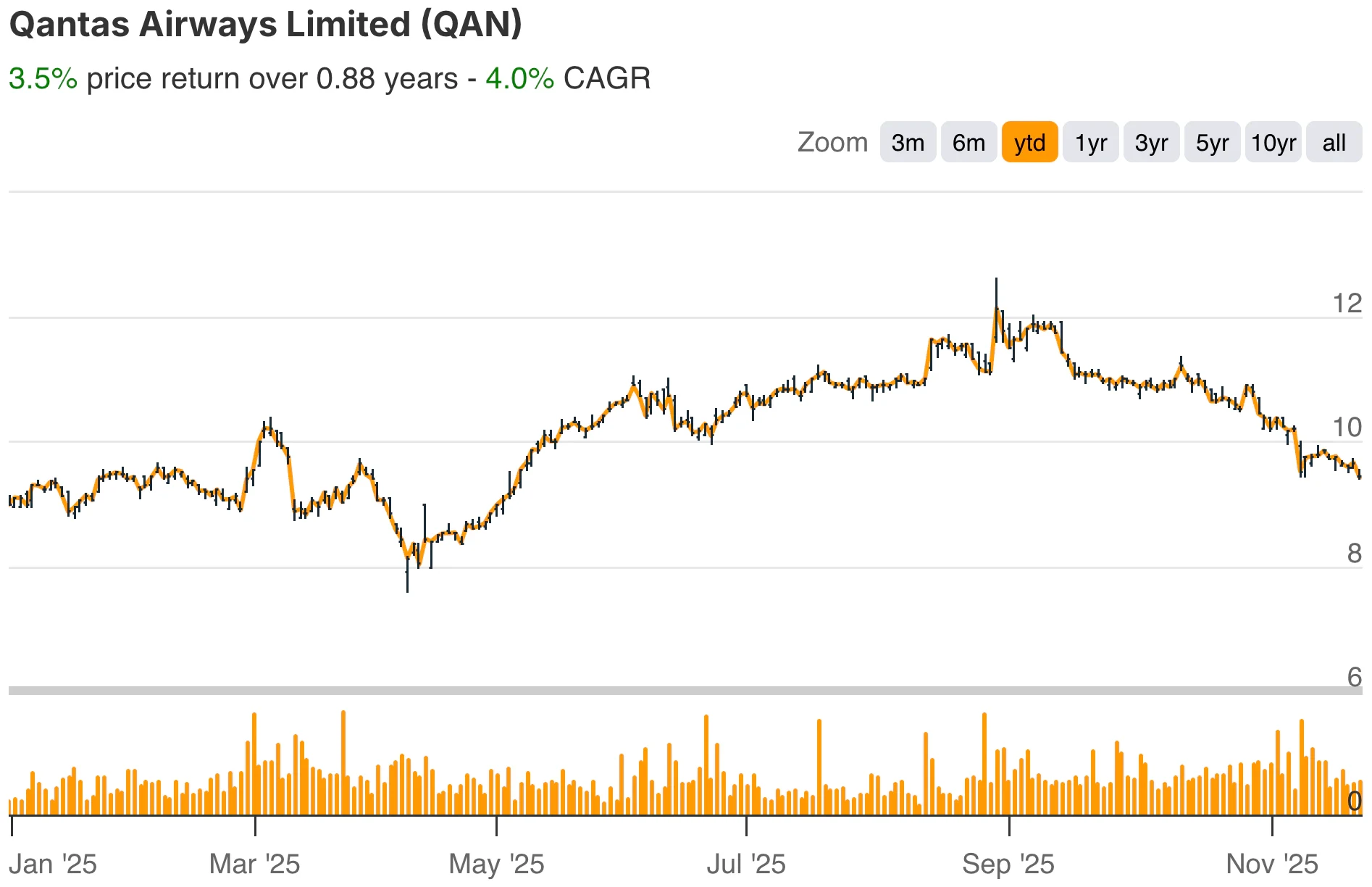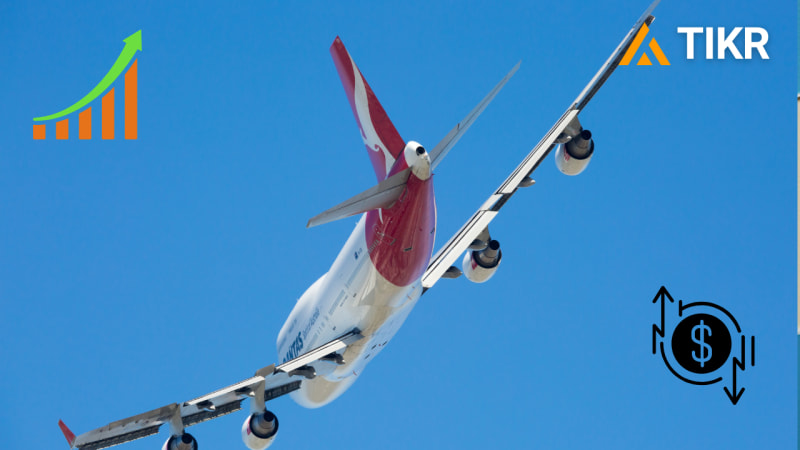Qantas (QAN) enters FY26 with a business that looks clearer than it did a year ago. Travel demand has settled into a more predictable rhythm, loyalty remains one of the sector’s strongest contributors, and the balance sheet carries less stress than during the post-pandemic surge. Investors have already seen the stock swing through several sentiment cycles, but the company has begun to show a steadier operational footing.
Find out what a stock’s really worth in under 60 seconds with TIKR’s new Valuation Model (It’s free)>>>
The core airline business continues to lean on domestic strength while restoring international capacity at a measured pace. Management highlighted that customer demand, network reliability, and aircraft utilization all improved through FY25. These gains helped offset higher labor costs and pockets of fuel volatility that shaped the past few quarters.

The broader story is simple in that Qantas has moved out of crisis mode and into a rebuilding phase. The next chapter depends on how well these operational improvements carry into FY26 and whether the updated fleet strategy and cost discipline can create a more stable earnings path.
Quickly value any stock with TIKR’s powerful new Valuation Model (It’s free!) >>>
Financial Story
The full-year numbers reflect a company that is still balancing recovery with ongoing industry pressures. Group revenue reached A$20.0 billion in FY25, up from A$18.4 billion in FY24 as both domestic and international travel stabilized. Strong load factors and firm pricing helped support performance, especially in the second half of the year. Loyalty revenue added another layer of predictability that investors continue to watch closely.
| Metric | FY25 | FY24 |
|---|---|---|
| Revenue | A$20.0b | A$18.4b |
| Net Income | A$1.15b | A$0.72b |
| Net Income Margin | 5.7% | 3.9% |
| Underlying EPS | A$0.58 | A$0.42 |
| Operating Cash Flow | A$3.2b | A$2.8b |
| Free Cash Flow | A$1.1b | A$1.0b |
Profitability showed mixed results. Net income margin reached 5.7 percent, up from 3.9 percent in FY24. Cost inflation in fuel and labor weighed on margins, but stronger capacity management, better operational planning, and early gains from efficiency measures kept the bottom line moving in the right direction. In several areas, particularly domestic operations, Qantas delivered healthier unit economics than many of its regional peers.
Cash flow trends strengthened as well. Operating cash flow improved due to steadier ticket sales, loyalty contributions, and better working capital discipline. Capital expenditure remained elevated because of the multi-year fleet renewal, but management kept the program aligned with long-term returns. Free cash flow held firm despite higher investment, which supported a more stable outlook heading into FY26.
Look up Qantas’ full financial results & estimates (It’s free)>>>
Broader Market Context
Global aviation remains uneven. Some regions have seen softer discretionary travel as household budgets tighten, while others continue to experience steady demand across premium and international routes. Fuel prices remain unpredictable, and capacity restoration across Asia-Pacific is still in motion. These elements make the sector more sensitive to execution than usual.
In Australia, airlines have benefited from more stable domestic travel and improved reliability across major networks. Competitive pressure remains high, particularly on core routes, but disciplined pricing and restored schedules have helped the market rebalance. Investors continue to look for signals that margins can hold as costs peak and the industry moves into a more normal operating environment.
1. Demand Trends and Revenue Stability
Travel demand has settled into a steadier pattern, giving management clearer visibility than at any point since the pandemic. Domestic routes showed consistent load factors, supported by business travel recovery and steady leisure demand. International routes continued to rebuild with measured capacity additions, particularly on long-haul segments where yields remained firm. Loyalty revenue also created stability, giving Qantas a reliable buffer even when ticket volumes shift.
This stability enables more thoughtful route planning and pricing decisions. With fewer abrupt swings in demand, the company has more room to focus on profitable allocation across aircraft and markets. Investors will be watching whether this consistency continues as competition picks up and as industry-wide capacity returns across Asia-Pacific. The next few quarters will show whether revenue stability can become a defining theme.
2. Cost Management and Margin Execution
Cost management was a central focus throughout FY25. Fuel and labor remained the largest pressure points, but improved aircraft utilization and early efficiency gains helped offset part of the impact. Management emphasized that simplification efforts and better planning created tangible benefits across the year. These improvements were not enough to fully neutralize inflation, but they provide a clearer view of how margins could strengthen as external costs ease.
The question now is whether this progress can compound in FY26. Consistent cost control will be essential if the company wants to maintain margin stability in a competitive market. Seasonal volatility and disruptions still influence short-term results, but cleaner execution across several reporting periods would show that the strategy is taking hold. Investors will look for a more predictable margin profile as the company moves into its next phase.
Value stocks like Qantas in less than 60 seconds with TIKR (It’s free) >>>
3. Long-Term Strategy and Fleet Renewal
The fleet renewal program is one of the most important components of the long-term outlook. New aircraft offer better fuel efficiency, lower maintenance requirements, and a more consistent customer experience. These benefits flow into the financials slowly, but they set the foundation for higher reliability and stronger margins over time. Management also signaled that the network will continue to be adjusted to focus on markets that deliver stable returns.
Long-term positioning will be shaped by how well these improvements translate into financial performance. A more efficient fleet, paired with a disciplined route strategy, can deliver meaningful operating leverage. Loyalty remains a strategic advantage for the company, and combining it with cost-efficient operations could improve earnings consistency. Investors will watch closely for early evidence of this shift through FY26.
The TIKR Takeaway

Qantas is no longer navigating crisis conditions. Revenue trends are more stable, loyalty remains a standout, and early cost improvements point toward a more balanced earnings profile. The valuation model highlights mid-range return potential if execution stays on track. The next series of results will determine how much of this progress carries forward.
Should You Buy, Sell, or Hold Qantas Stock in 2025?
The company sits at a turning point with clearer trends but persistent volatility. Early wins in cost control and fleet strategy offer positive signals, while margins still require confirmation. Investors may want to watch for steadier quarters to understand how durable the reset will be through FY26.
How Much Upside Does Qantas Stock Have From Here?
With TIKR’s new Valuation Model tool, you can estimate a stock’s potential share price in under a minute.
All it takes is three simple inputs:
- Revenue Growth
- Operating Margins
- Exit P/E Multiple
If you’re not sure what to enter, TIKR automatically fills in each input using analysts’ consensus estimates, giving you a quick, reliable starting point.
From there, TIKR calculates the potential share price and total returns under Bull, Base, and Bear scenarios so you can quickly see whether a stock looks undervalued or overvalued.
Find out what your favorite stocks are really worth (Free with TIKR) >>>
Looking for New Opportunities?
- See what stocks billionaire investors are buying so you can follow the smart money.
- Analyze stocks in as little as 5 minutes with TIKR’s all-in-one, easy-to-use platform.
- The more rocks you overturn… the more opportunities you’ll uncover. Search 100K+ global stocks, global top investor holdings, and more with TIKR.
Disclaimer:
Please note that the articles on TIKR are not intended to serve as investment or financial advice from TIKR or our content team, nor are they recommendations to buy or sell any stocks. We create our content based on TIKR Terminal’s investment data and analysts’ estimates. Our analysis might not include recent company news or important updates. TIKR has no position in any stocks mentioned. Thank you for reading, and happy investing!








